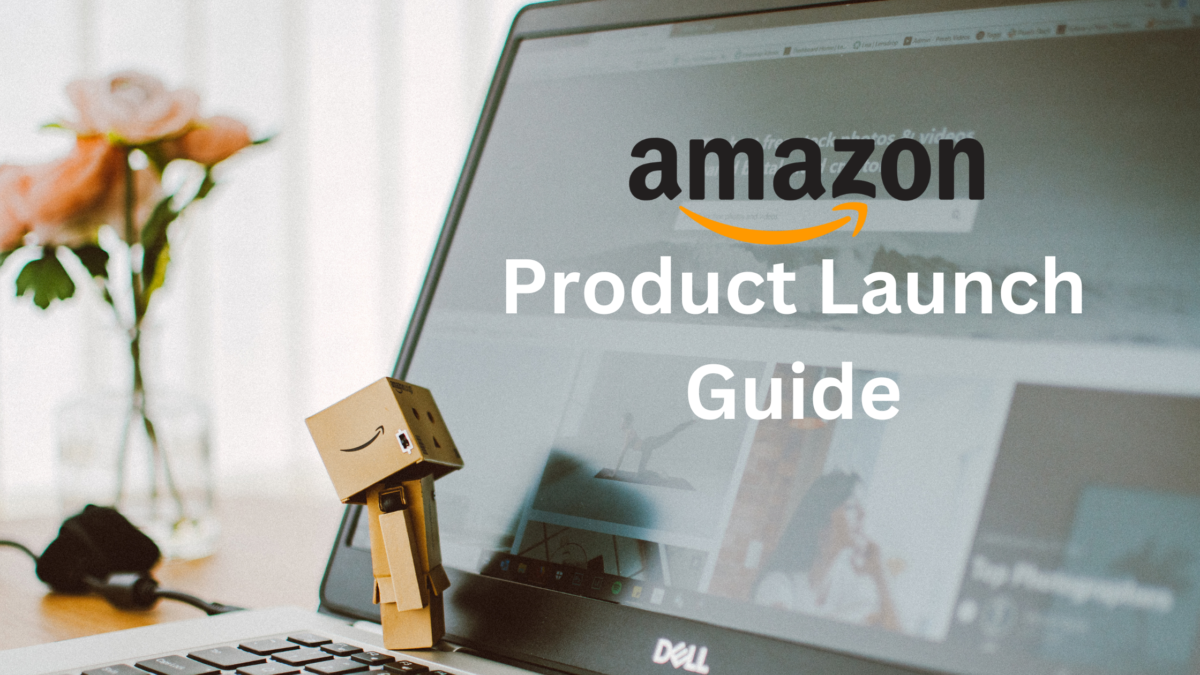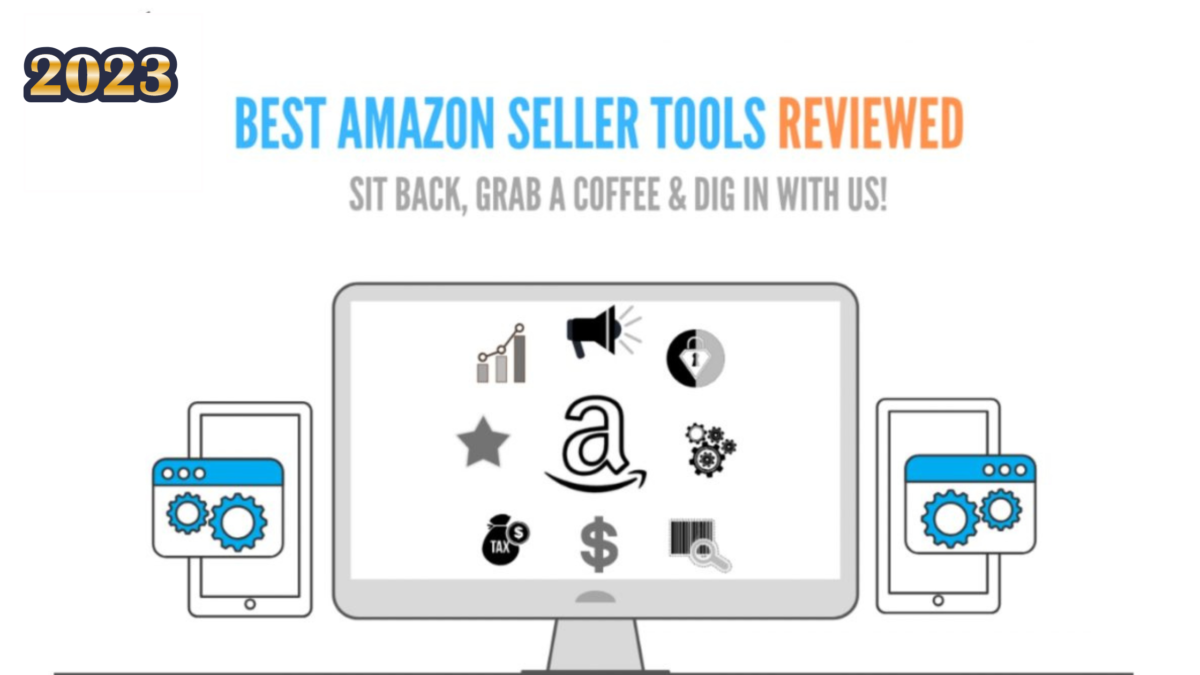Keyword research is arguably the single most important aspect of selling on Amazon.
After all, keyword optimization is how the right people will find your product listings.
If you have targeted irrelevant keywords, ones with low buyer intent, or simply not enough keywords, you are going to be fighting against the tide in your attempt to grow and scale your business.
Target a wide range of appropriate keywords, however, and you give your products the best possible chance of being seen by anybody and everybody that they could appeal to.
Unfortunately for most newcomers to Amazon FBA, the majority of the existing online resources for Amazon keyword research are either embarrassingly basic, or too technical and in-depth for the average beginner to understand.
We thought we would solve this by bringing you some Amazon keyword tips we’ve used along with our unique ranking process to achieve unmatched results for our clients – all in plain English!
Let’s start with why this is so important:
How to Do Keyword Research for Amazon

The first thing to be aware of is Amazon’s A9 Algorithm and how it works.
It’s very easy to forget that Amazon is essentially a search engine just like Google.
It ranks products for each possible keyword based on a variety of factors – with the most important factor being organic sales.
Amazon always wants to provide potential customers with the product that has the highest chance of converting to a sale. Each time somebody searches a keyword and purchases your product, this tells Amazon that your product is highly relevant and tempting to somebody looking for that particular phrase.
When this happens, you can expect your product to show up higher within that keyword.
Of course, succeeding on Amazon isn’t quite as simple as this, and there are 4 main things to take into account when attempting to rank organically for a keyword:
- Images/Listing
- Reviews
- Relevance
- Pricing
Your product listing and images should be just as attractive as the competing products within the listing, or ideally, more so.
You should also have mostly positive reviews, ideally in a comparable number to the competition.
Your product needs to be as relevant to the keyword as possible. For example, if you’re selling a mosquito repellent spray and you rank well for the keyword “mosquito spray”, then you can expect people searching that keyword to be interested in your product. But if you rank it for “mosquito cream”, you can expect less sales, because anybody typing that keyword is specifically looking for a cream.
It really is that simple, and applying a little bit of logic to the intent behind keywords will go a long way.
Lastly, if your price is comparable or lower than the competition, you can expect many of the potential customers to go ahead and choose your product.
If all of the above is true, then once you’ve ranked for a keyword, you can expect to stay there and continually gain organic sales. But if any of the above aren’t the case, for example, if your price is considerably higher than the competition and your images aren’t the best quality – consumers may continue to choose the competition, leading to you losing ranks again over time.
The key to success on Amazon is:
- Ensuring your product is high quality
- Ensuring all of the above factors are completed to the best possible quality
- Completing in-depth keyword research to prioritise the most relevant keywords to your product
- Using keyword focused sales campaigns to rank for the above keywords
There are several different techniques you can use to find the most appropriate keywords, but the easiest and most efficient way is usually to use a software tool built for this purpose, such as Helium 10.
If you’re a relatively new Amazon seller, you may not be able to afford something like this, in which case there are some free options available (KeywordTool.io is one of the best free Amazon keyword research tools) but these unfortunately often have much less accurate data than the more premium options.
There is one reliable way to get Amazon keyword ideas directly from Amazon’s search engine, and while it doesn’t provide search volumes, it’s incredibly easy to do.
Let’s take a look at that next:
How to Get Free Keyword Ideas from Amazon
You’ve likely noticed this already, but if you begin to type a search query into Amazon, it will provide ideas for what you might be looking for:
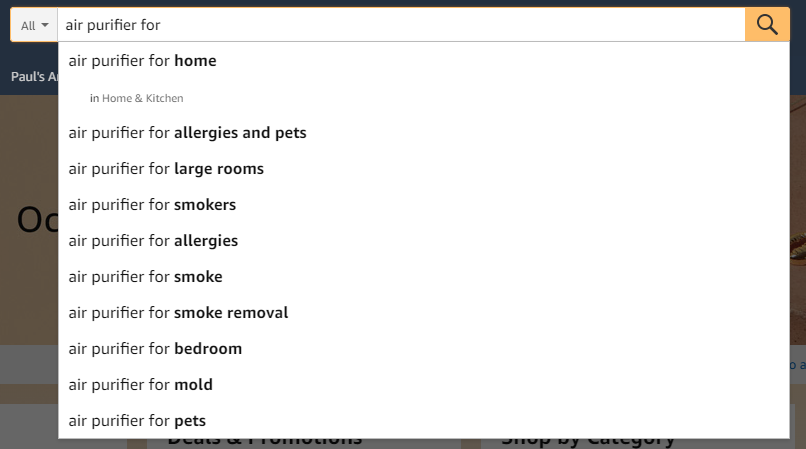
You can even go further in-depth by adding every letter of the alphabet after the search, for example “air purifier for a”, “air purifier for b” etc.
For those of you who are able to afford an Amazon keyword research tool, we would say this is an absolute must due to the more accurate data and more complete functionality they provide.
Here are some of the best options on the market for that:
Best Keyword Research Tools for Amazon
Helium 10
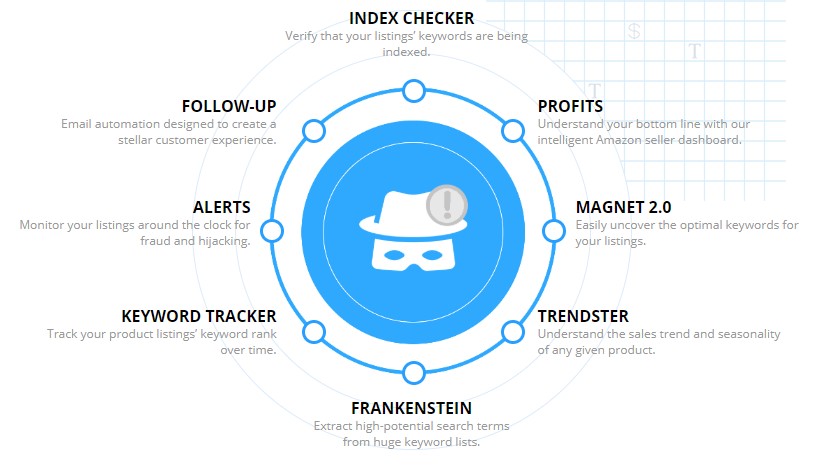
Helium10 is one of the most popular Amazon seller tools out there, and for good reason.
It provides a full range of different tools, some of which are excellent, some of which are a little more lacking.
But it’s keyword research tool specifically, is one of the best in the business.
It allows you to search any keyword you like, and will provide you with thousands of potentially related keywords, all with accurate search volume data.
This allows you to browse through the list, removing those that are inappropriate, and building out a perfect list of keywords to target, and the accurate search volumes let you prioritise which to target effectively.
It also allows you to track the organic ranks of products in these keywords, allowing you to learn which of your marketing efforts work and which don’t – although it doesn’t do this quite as well as KeyworX.
To learn more about Helium10, check out our industry-leading review of the tool here, or use the code below to sign up with a lifelong discount:

Sonar
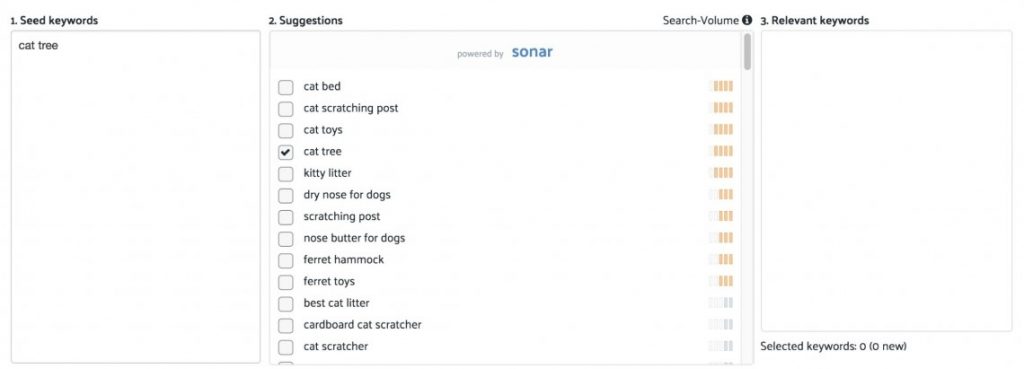
Sonar is the Amazon keyword research solution offered by Sellics, another comprehensive package of tools.
It’s a powerful option to find out the most profitable keywords in your niche, who is currently ranking for them, and how they have achieved it.
This can in turn influence your own marketing decisions and make it easier to compete with these established sellers.
Now that you have some great options for getting keyword ideas, what exactly do you do with them, and how is this built out into a workable keyword strategy?
This will become natural in time with experience, but in the first instance we recommend using the following steps:
1: Get a Selection of “Seed” Keywords
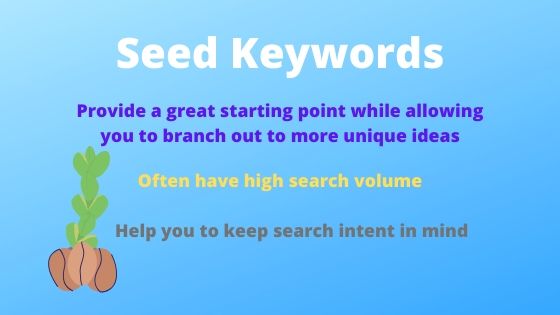
First, you should decide on a small selection of keywords to represent the sort of product you’re trying to sell.
They should be relatively short, but highly descriptive of your product.
For example, if you’re trying to sell grain free, high protein dry dog food, a great starting point would be “grain free dog food”, “high protein dog food” and “dry dog food”.
Now that you have these, it’s time to generate as many relevant keywords as possible related to these topics:
2: Generate Related Keyword Ideas

While the first stage was based on your own logic, it’s time to use real data to get as many keywords as possible so that you know exactly what your potential buyers are searching.
The best way to get these is to use one of the premium keyword research tools discussed above, as they will provide a full breakdown of all the possible keywords related to your niche, with associated search volumes.
If you’re just starting out and can’t afford such a tool – you can use the Amazon search bar technique listed above. This will put you at a disadvantage without knowing how often these terms are searched, but at least you’ll be able to get a bunch of relevant ideas.
If you have one of the more comprehensive tools, however, then you’ll have more options at your disposal.
Today we’ll show you Helium10’s Keyword Research tool, MAGNET2, since this is one of our favourites.
All you need to do, is type in your seed keyword to get a huge list of keywords that are potentially related:
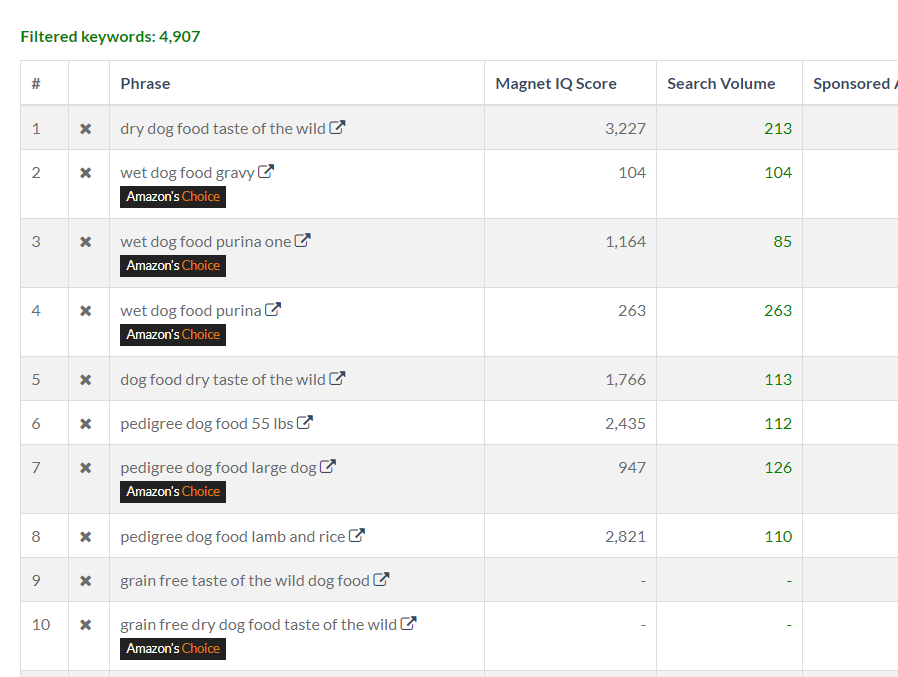
The issue is, many of these won’t be exactly what you’re looking for.
So the next stage is to go through the entire list and think “would somebody typing this keyword be interested in my product”?
For many, the answer will be no. For example, “wet dog food purina”. Somebody typing this is both looking for wet food, which our product is not, and also looking for a specific brand that isn’t ours.
As a result, there is no point using this keyword to optimize our listing. Even if we manage to get a good rank, people who type it will continue to buy Purina’s wet offerings in the majority of cases, and we will rapidly lose ranks again.
As you go through the list and cut down all of the irrelevant keywords, you will eventually get a much smaller list of keywords you can genuinely use.
3: Use Them in Your Listing

Now you want to get as many of these keywords into your listing as possible. Make use of the title, bullet points, product description, backend search terms, and everywhere you possibly can.
Of course, your listing still needs to be well-written copy that helps convert real humans into customers, so don’t jam pack it so full of keywords that it reads awkwardly.
But as long as you can find the balance between persuasive writing and keyword optimization, you’ll begin to rank for these keywords and show up in the search results when people type them.
4: Increase Your Ranks!

If you’ve done all of the above steps correctly, you’ll now be ranked for several relevant keywords giving customers a real chance to find you.
The problem is, if you’re a new seller in an established niche, chances are that the first page is already full of attractive products, and you’re somewhere on page 7.
If this is the case, then you won’t be winning any sales no matter how many keywords you’re ranked for, since nobody will see your product regardless.
So how do you get your product to show up higher?
Remember earlier when we said Amazon orders these products by how likely they are to sell under this specific keyword?
That’s your answer – the only way to get your product to show up higher in a given keyword is to generate genuine sales for the product under that exact keyword.
For example, let’s say my dog food is showing up 150th for “dry dog food”. This is on the 3rd page and won’t be benefitting me. If I can get 50 people to search that keyword and purchase my product, the rank will gradually increase each and every time.
If I can get all 50 to do it in a short period of time (say, 6-7 days) I could propel my product to a top 10 rank, showing at the top of the first page, or potentially even 1st place.
From there, as long as my product is relevant to the keyword and attractive to the people who search it, it will begin to generate genuine organic sales, and therefore maintain it’s rank.
If done correctly, this method has a higher ROI than PPC, external advertising, or any other form of Amazon marketing.
Of course, to rank in a keyword with 100,000 searches per month, you’ll need many more sales than one with 1,000. As a result, it’s often a good idea to target the smallest keywords first in order to achieve rapid rank increases.
The extra sales generated by this can then be used to fund attacks on larger keywords which can transform your business forever.
The cheapest and easiest way to do this is to simply ask friends and family to help you out by buying your product and reimbursing them. However, sometimes it can be hard to find enough people. If you struggle with this, take a look at our unique ranking process in which we use our network of genuine buyers to push your product to where it needs to be.
What if My Rank Doesn’t Stay?
If you do the above correctly, you’ll stay in a high rank for the keyword and constantly generate sales. However, there is a chance you’ll slowly begin to slip out of the ranks again.
This is a sign that other products within this keyword are still doing better than you so Amazon is slowly pushing them up again.
Why would this happen?
Here are the most common reasons:
- The keyword you targeted isn’t quite relevant enough
- The benefits of your product aren’t obvious from the image or title, whereas the benefits of other products are, leading potential customers to click them first
- Your reviews are too negative or too low in number to be considered trustworthy
- Your enhanced brand content, product images, or listing copy are not effective enough
Usually, by keeping these reasons in mind, and scanning the other results within the keyword, you can figure out why Amazon users are choosing other products over your own.
If so, it may simply be a case of reoptimizing your listing, then running another set of sales.
As long as you have a great quality product that is in demand, there is no reason this strategy can’t work for anybody.
If you don’t believe me, check the results we’ve achieved for some of our clients through this exact strategy!
